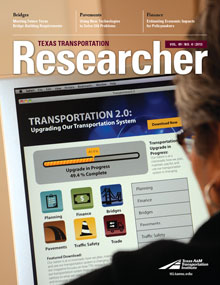“Everything about the Texas transportation system is changing,” says Ginger Goodin, director of the Texas A&M Transportation Institute’s (TTI’s) new Policy Research Center (PRC). “The old way of doing things just isn’t feasible anymore.”

Goodin is essentially referring to the old solution of simply building more roads to meet our state’s mobility needs. While adding to infrastructure is part of the solution to systemic issues with the Texas transportation system, constructing our way to greater mobility has become prohibitively expensive in the Lone Star State.
But broadening the set of solutions requires revising legislative, institutional arrangements and public engagement approaches to find that better way. To that end, the Texas Legislature funded the PRC in the last session, and in November 2013, the Texas A&M University System Board of Regents approved designation of the center at TTI. Goodin sums up the purpose, vision and goals of the PRC as aiming to transform transportation in Texas through research, collaboration and policy innovation. The center’s team is assessing the big picture of transportation needs and providing information to policymakers within the context of how:
- technology and data can facilitate solutions,
- the transportation system can be funded in the face of evolving economic pressures, and
- we can best meet the needs of Texas’ rapidly growing population.
To find answers, researchers pursuing PRC projects will focus on six areas: finance, freight, congestion, public engagement, technology and transportation data. While each of the areas has a team leader, the center’s strategic approach involves putting together cross-disciplinary teams using the guiding principles of credibility, clarity and creativity. Ultimately, the PRC‘s research is intended to more effectively inform policy discussions and actions.
“The Texas Legislature’s reliance on TTI expertise has increased quite a lot over the past few sessions,” says Cathy Reiley, the center’s associate director. “By funding this research, they’re sending a strong message about the high value they assign to the work this agency is doing.”
